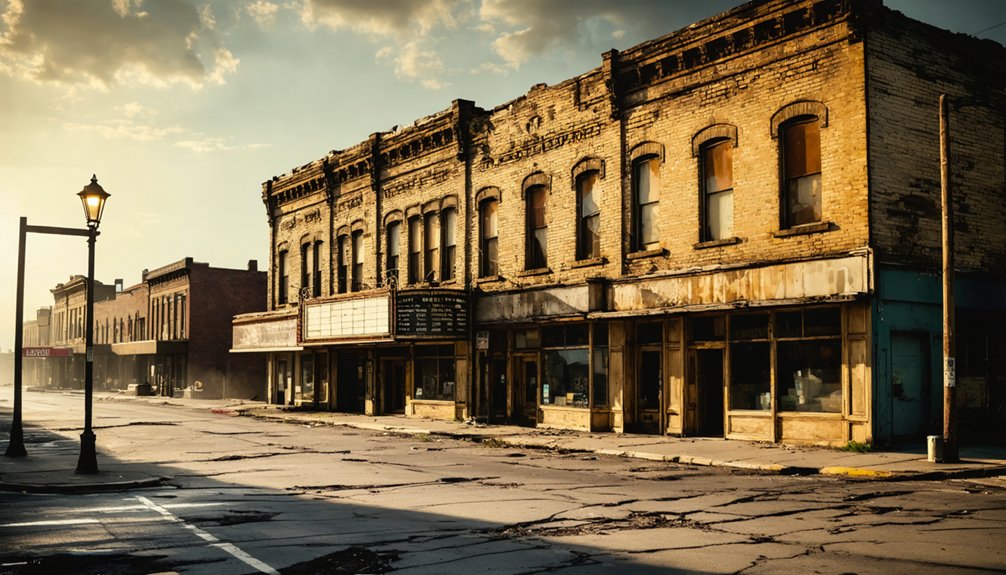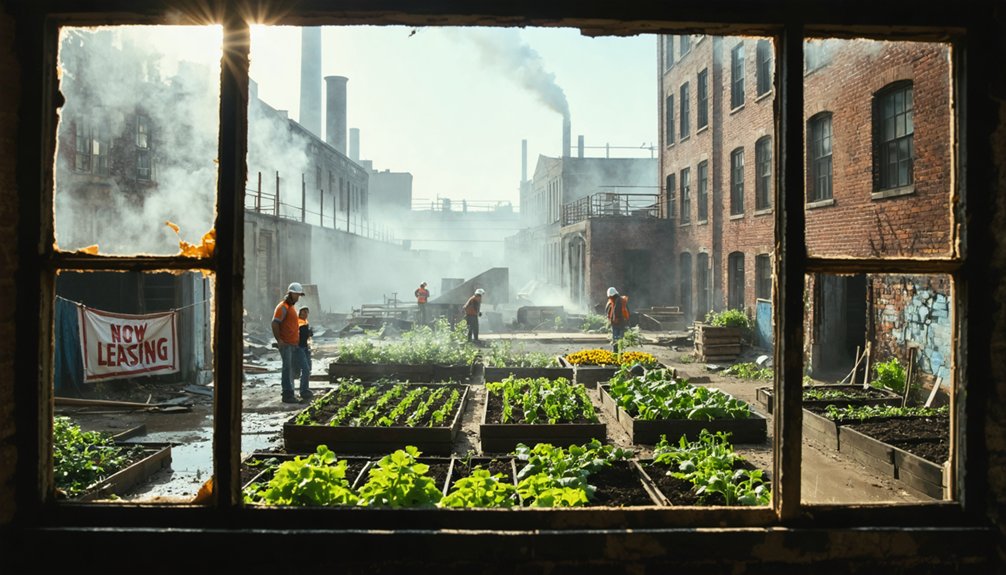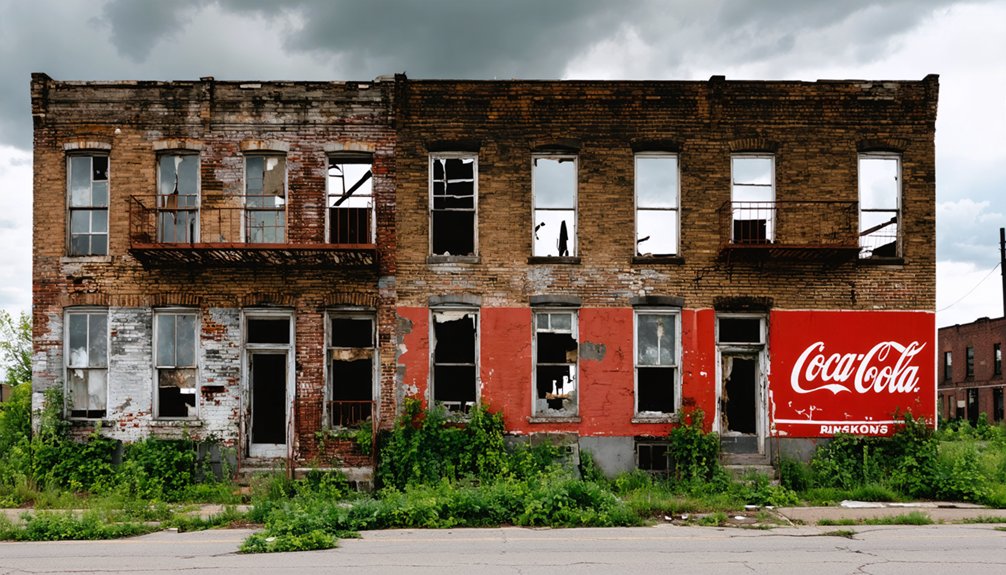You’ll find America’s industrial decline haunting the skeletal remains of the Rust Belt’s ghost towns. From Gary’s abandoned steel mills to Youngstown’s “Black Monday” aftermath, these once-thriving communities now showcase crumbling Victorian mansions, factories reclaimed by nature, and empty neighborhoods. Pittsburgh’s mill towns, Flint’s shuttered plants, and Buffalo’s East Side tell stories of economic trauma, systemic racism, and broken social contracts. The architectural remnants await those seeking America’s forgotten industrial heritage.
Key Takeaways
- Gary, Indiana has experienced 61% population decline since 1960, with one-third of homes abandoned and severe urban blight.
- Youngstown, Ohio suffered catastrophic steel industry collapse after “Black Monday” in 1977, earning nicknames like “Crime City USA.”
- Pittsburgh’s mill towns lost 80-90% of peak populations, leaving abandoned factories and crumbling infrastructure across the landscape.
- Flint, Michigan’s abandoned GM factories represent industrial capitalism’s boom-bust cycle, with 90% workforce reduction causing economic despair.
- Buffalo’s East Side features crumbling factories, vacant lots, and abandoned landmarks like the Wonder Bread Factory amid segregation and neglect.
The Lost Steel City of Youngstown, Ohio
While many American cities experienced industrial decline in the late 20th century, Youngstown, Ohio stands as perhaps the most striking example of steel industry collapse and its devastating aftermath.
Few cities embody industrial decline like Youngstown, where the collapse of steel manufacturing left an indelible scar on the American heartland.
You’ll find a city where steel legacy once reigned supreme, producing millions of tons during WWII and employing thousands in sprawling mills.
The city’s steel mills produced an essential part of the 427 million tons of American steel manufactured during World War II.
But since “Black Monday” in 1977, when Youngstown Sheet and Tube shuttered operations, the city’s transformation into a ghost town has been dramatic.
Urban decay now defines vast stretches where bustling factories once stood.
Walk through Youngstown today, and you’ll encounter abandoned industrial complexes, their skeletal remains looming over neighborhoods where population has plummeted by 70%.
Crime rates escalated sharply, earning the city notorious nicknames like “Bomb Town” and “Crime City USA.”
Yet amid the ruins, you’ll discover pockets of renewal through education and technology initiatives.
St. Louis’s Forgotten North Side
As St. Louis’s North Side shows you the stark reality of America’s urban decay, you’ll witness the devastating impact of misguided urban renewal policies and systematic disinvestment.
Once a thriving industrial hub with 880,000 residents in the 1950s, the city’s population has plummeted to less than 300,000 today, with North Side bearing the heaviest burden.
You’ll find block after block of abandoned buildings, their bricks stripped away by scavengers, while racial restrictions and white flight have left deep scars on the community. Inside these vacant structures, personal artifacts remain, telling silent stories of families forced to leave their homes behind. The area’s decline accelerated after racial housing ordinances in 1916 formally segregated neighborhoods.
Despite having the highest murder rate outside South America, pockets of community resilience persist. Local organizations and remaining residents fight to preserve their neighborhood’s identity, even as they grapple with poverty, violence, and governmental neglect.
While city officials pursue eminent domain strategies, the future of this forgotten district hangs in precarious balance.
Montgomery’s Crumbling Downtown District
Ghosts of Montgomery’s prosperous past haunt its crumbling downtown district, where abandoned Art Deco facades and deteriorating antebellum buildings tell the story of a once-thriving Southern capital.
You’ll find the tragic remnants of urban decay most evident in Capitol Towers Apartments, where the deadly 1967 fire claimed 26 lives and left behind reported apparitions of phantom smoke and shadowy figures.
The city’s decline mirrors a familiar pattern: suburban flight, deindustrialization, and the lingering impact of Civil War history. Like many Rust Belt communities, Montgomery suffered when global competition forced local manufacturers to close their doors.
Walking these streets, you’ll encounter the legendary Lady in White, whose animal-like teeth and spectral presence exemplify the district’s eerie atmosphere.
The Lady in White stalks downtown Montgomery’s shadows, her feral grin and ghostly form haunting those who dare walk alone.
While historical preservation efforts focus on Old Alabama Town’s restored structures, much of downtown remains caught between its storied past and an uncertain future, with vacant buildings awaiting their next chapter.
Near the State Capitol, visitors report hearing ear-piercing wails and seeing faucets mysteriously run with blood during nighttime hours.
The Empty Streets of Kansas City’s Ingleside
Hidden beneath Kansas City’s modern sprawl lies the forgotten community of Ingleside, where weathered foundations and a solitary general store serve as the last physical remnants of a once-thriving rural settlement.
Much like the nearby town of Midway, where only trees remain of its railroad shipping legacy, Ingleside’s story mirrors the fate of many mining communities in the region.
You’ll find these Ingleside memories scattered across streets that still bear the town’s name, telling tales of a vibrant agricultural past that flourished from the 1880s until urban decay took hold.
Similar to how Clinton Lake waters submerged several small Kansas towns, as you explore the area today, you’re walking through layers of history where urban development has swallowed most traces of this 19th-century community.
The crumbling general store stands as a silent witness to the town’s decline, while nearby cemeteries preserve the stories of early settlers.
Local preservation groups are fighting to document these remaining structures before they vanish completely into Kansas City’s expanding footprint.
Gary, Indiana: A Steel Giant’s Fall
As you walk through Gary’s abandoned streets today, you’ll find the haunting remnants of what was once America’s mightiest steel town, where U.S. Steel’s Gary Works employed over 30,000 workers at its peak.
The city’s dramatic decline since the 1960s mirrors the broader collapse of American steel manufacturing, with its population plummeting from 175,000 to under 70,000 as factories automated and jobs vanished. Today, nearly twenty percent of all buildings in the city stand abandoned, creating an eerie urban landscape.
The skeletal remains of Gary’s industrial might still loom over the cityscape, from the massive but largely silent steel mills to the countless vacant buildings that once housed its prosperous working class. A history of racial segregation and redlining has compounded the city’s struggles, with African American residents facing systemic barriers to economic recovery.
Steel Mills Stand Silent
Once a marvel of industrial might, Gary Works now stands as a haunting reminder of American manufacturing’s decline.
You’ll find the massive 8,000-acre complex eerily quiet compared to its heyday, when 12 blast furnaces and nearly 100 open hearth furnaces transformed the landscape into a cathedral of industry.
Though still North America’s largest integrated mill with 8.2 million tons of annual capacity, the steel industry’s contraction has left sections of this industrial titan dormant.
The urban decay surrounding the mill tells a deeper story—where over 500 workers sacrificed their lives since 1906 amid dangerous conditions.
The $100 million investment that once symbolized industrial promise now represents the Rust Belt’s painful transformation.
The mill’s imposing structures, industrial canal, and harbor remain as architectural monuments to freedom through economic opportunity—now largely unfulfilled.
Population Exodus Since 1960s
When Gary’s population peaked at nearly 178,000 residents in 1960, few could have anticipated the precipitous decline that would transform this industrial powerhouse into a hollow shell of its former self.
You’re witnessing the aftermath of a 61% population decline—from steel boom to desperate exodus. As you drive through Gary today, the city’s socioeconomic collapse is written in its landscape: one-third of homes stand abandoned, their architectural details crumbling into urban blight.
The demographic shift is stark—white residents plummeted from 46.7% to under 15% as middle-class families fled. What remains is a fragmented tax base struggling to maintain basic services.
Empty streets, shuttered businesses, and decaying infrastructure tell the story of global economic forces that devastated an entire community, leaving just 67,000 residents clinging to a city designed for nearly three times that number.
Detroit’s Brush Park: From Mansions to Ruins
Wandering through Brush Park’s weathered streets, you’ll confront the sobering transformation of “Little Paris” from an enclave of 300 Victorian mansions into a symbolic landscape of Rust Belt decline.
The neighborhood’s skeletal French Renaissance and Venetian Gothic structures stand as architectural monuments to Detroit’s industrial boom and subsequent economic collapse.
While urban explorers capture the haunting beauty of these crumbling facades, each empty window and decaying cornice reveals deeper narratives about class mobility, racial dynamics, and the stark reality of American deindustrialization.
Victorian Grandeur Lost Forever
The devastating transformation of Brush Park from Detroit’s crown jewel to a shadow of its former self represents one of America’s most profound architectural tragedies.
In the 1950s, you’d have witnessed the systematic erasure of over 300 Victorian mansions under the banner of “slum clearance.” This neighborhood, once dubbed “The Little Paris of Detroit,” fell victim to misguided urban renewal policies that prioritized demolition over preservation.
Each Venetian Gothic, Italianate, and Queen Anne masterpiece that fell represented the obliteration of Gilded Age craftsmanship that can never be replicated.
- The ghosts of 19th-century lumber barons and merchants haunt empty lots where architectural marvels once stood
- Ornate cornices, hand-carved woodwork, and stained glass windows—all reduced to rubble
- The destruction serves as a stark reminder of how quickly prosperity and heritage can vanish
Empty Streets Tell Stories
Silent roads stretch through Brush Park‘s skeletal remains, each abandoned lot and crumbling Victorian facade chronicling Detroit’s dramatic socioeconomic collapse.
You’re witnessing the aftermath of industrial decline and racial segregation that emptied these streets—where once 300 homes housed the city’s elite, only 80 structures remain amid urban decay.
Walking these blocks, you’ll find mansions designed by Albert Kahn and Henry Brush now standing as hollow monuments to failed urban policies.
Insurance redlining and white flight transformed “Little Paris” into forgotten ruins.
Yet among the emptiness, architectural revival stirs. Bedrock’s City Modern project and the restoration of the Ransom Gillis House signal a neighborhood refusing to surrender its story.
These vacant thoroughfares aren’t just evidence of decline—they’re becoming canvases for Detroit’s reinvention through preservation and renewal.
Buffalo’s Abandoned East Side

Once a vibrant cornerstone of Buffalo’s industrial might, the East Side now stands as a stark monument to the city’s socioeconomic decline and racial segregation.
As you walk its streets, you’ll witness the physical manifestation of systemic racism and economic abandonment—crumbling factories, vacant lots where homes once stood, and the concrete scar of an expressway that physically divided the community.
- Abandoned landmarks like the Wonder Bread Factory and Sattler Theater whisper stories of a forgotten golden era
- Empty lots and “urban prairie” stretch for acres where Polish families once lived before fleeing to suburbs
- Predatory investment practices and mass demolition campaigns have left housing values devastated
Despite these challenges, community revitalization efforts including urban farming initiatives like Common Roots provide glimpses of resistance against decades of orchestrated decline.
The Ghost Factories of Flint, Michigan
Amidst the crumbling facades of what was once America’s automotive heartland, Flint’s abandoned factories stand as monolithic symbols to industrial capitalism’s boom-and-bust cycle.
Like industrial gravestones, Flint’s decaying factories mark the lifecycle of American manufacturing—born, thrived, abandoned.
The iconic Fisher Body Plant No. 1, where workers once staged the pivotal 1936-37 sit-down strike, now exists only as a skeletal administration building—Billy Durant’s office a lonely relic of former glory.
You’ll witness the devastating aftermath of GM’s exodus, which obliterated 90% of its workforce and triggered profound economic despair.
These ghost factories—concrete slabs and hazardous brownfields—represent more than abandoned real estate; they’re physical manifestations of broken social contracts.
As you navigate Flint’s industrial carcasses, understand you’re walking through the remains of America’s manufacturing promise—a stark warning about the vulnerability of single-industry towns and the human cost of corporate disinvestment.
Pittsburgh’s Dying Mill Towns

If you explore Pittsburgh’s once-thriving steel towns like McKeesport, Homestead, and Braddock today, you’ll witness the haunting aftermath of industrial collapse where abandoned factories stand as rusting monuments to a vanished economic era.
These communities, having lost 80-90% of their peak populations following mill closures in the 1970s-80s, continue to grapple with widespread poverty, vacant storefronts, and crumbling infrastructure that define their post-industrial landscape.
Yet amid this decay, small revitalization efforts have emerged through strategic diversification, historic preservation of industrial architecture, and attempts to reconnect these isolated suburbs to Pittsburgh’s evolving economy.
Steel Heritage Left Behind
When Andrew Carnegie opened the Edgar Thomson Steel Works in 1875, he couldn’t have foreseen the eventual ghostly fate of Pittsburgh’s mill towns.
Today, you’ll find silent blast furnaces and abandoned factories standing as rusted monuments to America’s industrial nostalgia. These skeletal structures, once the economic backbone of vibrant communities, now crumble beneath decades of neglect while nature slowly reclaims them.
- Empty homes with collapsing roofs line streets where generations of steelworkers raised families
- Massive, cathedral-like mill buildings stand in eerie silence, their broken windows like hollow eyes
- Weathered rail lines disappear into overgrown brush, leading nowhere
The architectural remnants of steel heritage reveal socioeconomic fault lines—where prosperity fled, leaving behind only physical memories of an era when Pittsburgh forged America’s skylines and infrastructure.
Economic Impact Still Echoes
The steel industry collapse of the early 1980s continues to reverberate through Pittsburgh’s once-thriving mill towns with devastating economic aftershocks.
You’ll find the scars everywhere—staggering job losses left 150,000 steel workers unemployed while manufacturing employment plummeted by 133,000 positions between 1979-1987.
As you drive through Monongahela Valley communities like Braddock, you’ll witness the architectural remnants of economic trauma—abandoned storefronts and crumbling infrastructure standing as silent monuments to vanished prosperity.
Where vibrant commercial districts once flourished, poverty rates have soared, creating pockets of isolation amid attempts at economic resilience.
While Pittsburgh proper has partially rebounded, these peripheral communities remain caught in structural unemployment‘s grip.
The challenge of community rebuilding continues decades later, with uneven recovery leaving many mill towns struggling to redefine themselves beyond their industrial heritage.
Modern Survival Strategies
Amid deteriorating infrastructure and economic hardship, Pittsburgh’s former mill towns have forged remarkable survival strategies that blend grassroots activism with strategic development initiatives.
You’ll find community resilience manifested through resident-led revitalization projects, where participation has grown from just a few dedicated individuals to packed town halls of nearly 100 stakeholders.
Local entrepreneurship flourishes as millennials establish coffee shops and boutique hotels in once-abandoned storefronts, creating economic ecosystems built on loyalty rather than corporate chains.
- Weathered brick facades that once housed industrial might now shelter innovative small businesses, their transformation symbolizing rebirth.
- Community gardens sprouting between vacant lots, reclaiming blighted spaces through collective determination.
- Century-old worker homes undergoing strategic renewal, preserving architectural heritage while meeting modern needs.
Cleveland’s Industrial Valley: A Deserted Legacy
Once America’s industrial heartbeat, Cleveland’s Industrial Valley now stands as a haunting memorial to the rise and fall of manufacturing prowess that defined the Rust Belt’s economic narrative.
You’ll find the skeletal remains of giants like National ACME, built in 1917 and shuttered by the 1990s after foreign competition decimated domestic production.
The Wellman-Seaver complex, with its striking floor-to-ceiling windows and rail spurs, represents both industrial heritage and potential rebirth through community engagement.
Since 1993, this engineering marvel has awaited its next chapter. Nearby, the Ashland Road buildings and Jaite Paper Mill tell similar stories of prosperity, decline, and abandonment.
These vacant cathedrals of industry remain powerful reminders of economic shifts that transformed neighborhoods and livelihoods, leaving behind architectural treasures awaiting rediscovery or reclamation.
Frequently Asked Questions
Are There Supernatural Hauntings in Abandoned Rust Belt Towns?
While supernatural sightings aren’t scientifically proven, ghostly legends thrive within decaying industrial architecture. You’ll find these narratives deeply intertwined with socioeconomic collapse, offering meaning amid the freedom of abandoned spaces.
What Safety Precautions Should Urban Explorers Take in Ghost Towns?
In urban exploration, you’ll need proper safety gear—respirators for asbestos-laden structures, sturdy boots traversing deteriorated floors, and headlamps revealing architectural nuances while freeing you to explore these socioeconomic time capsules responsibly.
How Can Photographers Legally Access Abandoned Rust Belt Properties?
You’ll need to research property ownership, secure permits as a photographer, contact historical societies, and build relationships with local communities. Consider public access sites or guided tours that showcase Rust Belt’s architectural decline.
Can You Purchase Abandoned Homes in These Areas?
Daring dreamers, you can purchase abandoned properties through tax auctions, city programs, or direct sales. Real estate laws vary by municipality, but acquisition often requires traversing delinquent taxes and committing to structural rehabilitation.
Which Rust Belt Ghost Towns Have Successful Revitalization Stories?
You’ll find Pittsburgh, Buffalo, Cincinnati, Akron, and Milwaukee have transformed through revitalization efforts combining adaptive reuse, economic diversification, and community involvement—reclaiming industrial architecture while creating vibrant urban spaces for residents.
References
- https://247wallst.com/special-report/2018/11/02/30-american-ghost-towns-3/
- https://en.wikipedia.org/wiki/Wikipedia:WikiProject_Ghost_towns
- https://www.geotab.com/ghost-towns/
- https://www.youtube.com/watch?v=0fwH0c-delI
- https://www.lovemoney.com/gallerylist/86648/americas-empty-ghost-towns-and-why-theyre-abandoned-today
- https://en.wikipedia.org/wiki/Ghost_town
- https://www.loveexploring.com/gallerylist/127789/then-and-now-us-rust-belt-cities-that-bounced-back
- https://www.youtube.com/watch?v=a7zS5kapSVw
- https://en.wikipedia.org/wiki/Rust_Belt
- https://www.slideshare.net/slideshow/famous-ghost-towns/26047073



